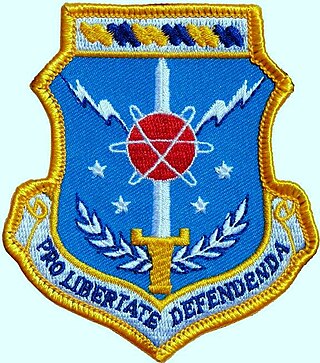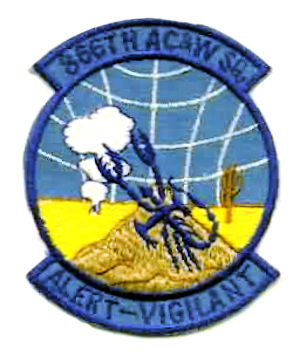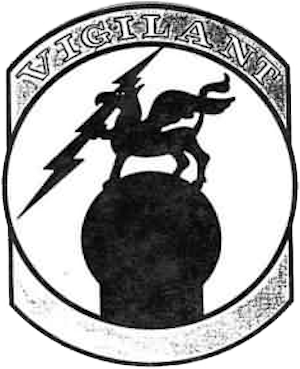
Kincheloe Air Force Base was a United States Air Force (USAF) base during the Cold War. Built in the Upper Peninsula of Michigan in 1943 during World War II, the base was in service until 1977.

Aerospace Defense Command was a major command of the United States Air Force, responsible for continental air defense. It was activated in 1968 and disbanded in 1980. Its predecessor, Air Defense Command, was established in 1946, briefly inactivated in 1950, reactivated in 1951, and then redesignated Aerospace rather than Air in 1968. Its mission was to provide air defense of the Continental United States (CONUS). It directly controlled all active measures, and was tasked to coordinate all passive means of air defense.

The 26th Air Division is an inactive United States Air Force organization. Its last assignment was with Air Defense Tactical Air Command, assigned to First Air Force, being stationed at March Air Force Base, California. It was inactivated on 30 September 1990.

Cross City Air Force Station is a former United States Air Force facility, located 1.6 miles (2.6 km) east of Cross City, Florida.

The Southwest Air Defense Sector (SWADS) is an inactive United States Air Force organization. Its last assignment was with the First Air Force, being stationed at March Air Force Base, California. It was inactivated on 31 December 1994.

Tonopah Air Force Station is a closed United States Air Force General Surveillance Radar station. It is located 1.1 miles (1.8 km) south of Tonopah, Nevada. It was closed in 1970.

The Spokane Air Defense Sector (SPADS) is an inactive United States Air Force organization. Its last assignment was with the Air Defense Command 25th Air Division at Larson Air Force Base in Grant County, Washington

The Detroit Air Defense Sector (DEADS) is an inactive United States Air Force organization. Its last assignment was with the Air Defense Command (ADC) 26th Air Division at Custer Air Force Station (AFS), Michigan. It was inactivated on 1 April 1966.
Bedford Air Force Station is a closed United States Air Force General Surveillance Radar station. It is located 12.7 miles (20.4 km) north of Bedford, Virginia. It was closed in 1975.
Palermo Air Force Station is a closed United States Air Force (USAF) General Surveillance Radar station. It was located in Palermo, New Jersey, 4.8 miles (7.7 km) north of Sea Isle City, in Cape May County, New Jersey, United States. It was closed in 1970.
Manassas Air Force Station is a closed United States Air Force General Surveillance Radar station. It is located 7.4 miles (11.9 km) west of Dale City, Virginia. It was closed in 1965.

Perrin Air Force Station is a closed United States Air Force General Surveillance Radar station. It is located 1.3 miles (2.1 km) southeast of North Texas Regional Airport, Texas. It was closed in 1969.

Rockport Air Force Station is a closed United States Air Force General Surveillance Radar station. It is located 4.1 miles (6.6 km) southwest of Lamar, Texas. It was closed in 1963.

Bellefontaine Air Force Station is a closed United States Air Force General Surveillance Radar station. It is located 2.3 miles (3.7 km) east-northeast of Bellefontaine, Ohio. It was closed in 1969.

Dallas Center Air Force Station is a United States Air Force General Surveillance Radar station 3.7 miles (6.0 km) northeast of Dallas Center, Iowa, that was closed in 1957.
Olathe Air Force Station is a former United States Air Force radar station that was located in Gardner, Kansas. It was located next to Naval Air Station Olathe, now the grounds of New Century AirCenter.

Winnemucca Air Force Station is a closed United States Air Force General Surveillance Radar station. It is located 3.1 miles (5.0 km) north-northwest of Winnemucca, Nevada. It was closed in 1968.
Lake Charles Air Force Station is a closed United States Air Force General Surveillance Radar station. It is located 3.8 miles (6.1 km) southeast of Lake Charles, Louisiana. It was closed in 1995 by the Air Force, and turned over to the Federal Aviation Administration (FAA).

Bangor Air National Guard Base is a United States Air National Guard base. Created in 1927 as the commercial Godfrey Field, the airfield was taken over by the U.S. Army just before World War II and renamed Godfrey Army Airfield and later Dow Army Airfield. It became Dow Air Force Base in 1947, when the newly formed U.S. Air Force took over many Army air assets. In 1968, the base was sold to the city of Bangor, Maine, to become Bangor International Airport but has since continued to host Maine Air National Guard units under a lease agreement with the city.
The 503d Aircraft Control and Warning Group (AC&WG) is an inactive United States Air Force unit. Its last assignment was with Air Defense Command (ADC)'s 26th Air Division at Roslyn AFS New York. It was inactivated in 1952.
















